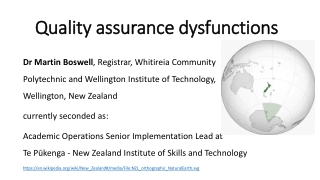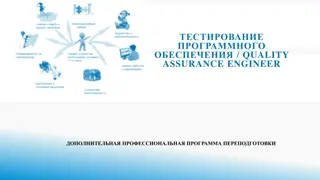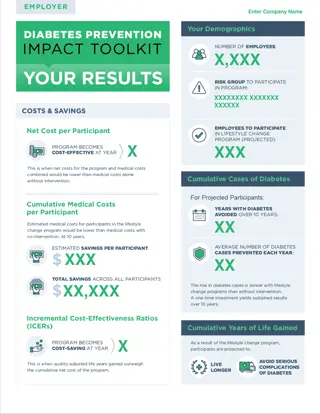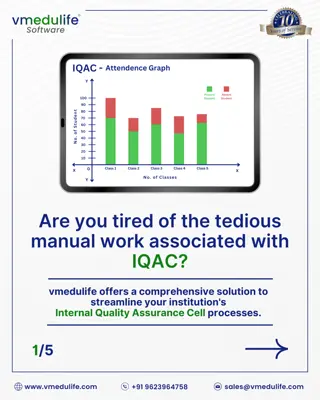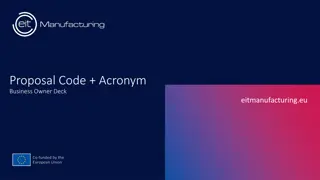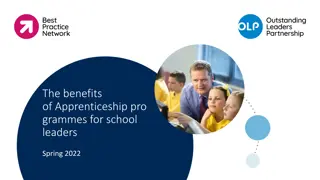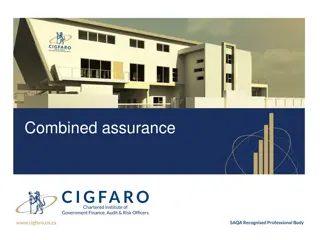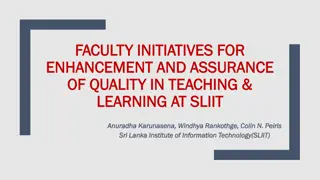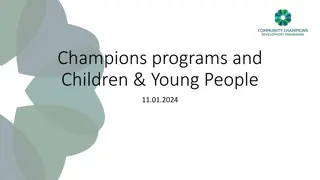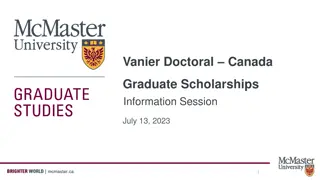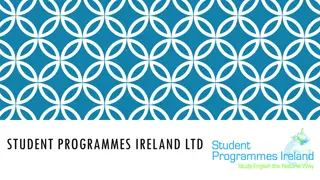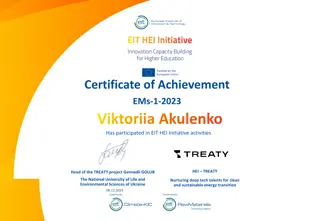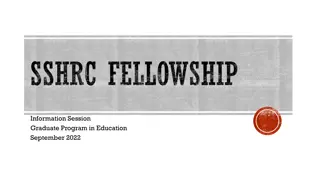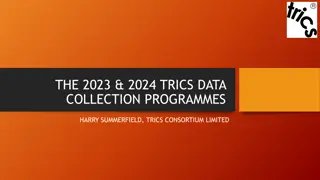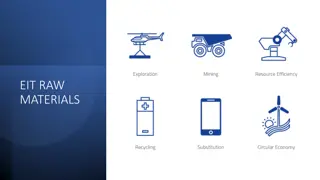Quality Assurance and Learning Enhancement Model for EIT Master and Doctoral Programmes
Developing a Quality Assurance and Learning Enhancement model for the European Institute of Innovation and Technology (EIT) Master and Doctoral Programs. The model focuses on integrating research, education, and innovation to address Europe's innovation gap and the need for a skilled workforce. It emphasizes creativity, innovation, entrepreneurship, and leadership skills within the context of knowledge transfer and sustainability. The EIT handbook outlines the planning, labelling, and review processes, with a focus on learning outcomes and suggestions for improvement. The EIT organization implements Mutual Overarching ILOs and a QA system to hold together its complex structure. The Educational Panel's meetings have led to the development of a comprehensive handbook for EIT programs.
Download Presentation

Please find below an Image/Link to download the presentation.
The content on the website is provided AS IS for your information and personal use only. It may not be sold, licensed, or shared on other websites without obtaining consent from the author. Download presentation by click this link. If you encounter any issues during the download, it is possible that the publisher has removed the file from their server.
E N D
Presentation Transcript
+ Quality for Learning Internal QA system for the European Institute of Innovation and Technology (EIT) Master and Doctoral Programmes Lena Adamson Associate professor of psychology/HE Expert Stockholm University (SU) lena.adamson@me.com lena.adamson@me.com
+ The knowledge triangle integrating research, education and innovation/business E Innovation and entrepreneurship R B/I lena.adamson@me.com
+ Today The EIT Quality Assurance and Learning Enhancement Model Quality for Learning The handbook (planning, labelling, follow up reviews) The process, learning outcome approach, EIT OLOs Some suggestions lena.adamson@me.com
European Institute of Innovation and Technology EIT + European body with the purpose to be a key driver and a role model addressing Europe s innovation gap (climate, energy and ICT, grand challenges ) Europe s need for a skilled work force: Master and doctoral programs, and CPD/professional l. Profile: Knowledge triangle skills and competencies, meaning skills and competencies in; Creativity innovation entrepreneurship leadership in relation to KT contexts making value and sustainability judgements in relation to the content of their educational programmes and subs. KIC themes Role model for European HE a. b. Not a new educational structure, 20 25 European top universities lena.adamson@me.com
+ Complex organisation how to hold it together? Mutual Overarching ILOs (EIT OLOs) and a mutual QA system for an EIT Label KICs - European Impact Climate-KIC: Co-location centre RIC (Regional Implementation Centre) EIT ICT Labs: Co-location centre Associate Partner KIC InnoEnergy Co-location centre lena.adamson@me.com
+ The process EIT Educational Panel Dec 2010 June 2012 approx. 10 meetings Result: Handbook Planned Revision 2016 Download handbook at http://eit.europa.eu/interact/bookshelf/handbook-planning- labelling-and-follow-reviewing-eit-master-and-doctoral lena.adamson@me.com
+ Handbook Content EIT a New Animal in the European Educational Landscape p 6 Introduction (gives an overview of the whole model) p 7 Part 1 Templates for Master Programmes p 9 Part 2 The EIT Label and the EIT QALE Model p 21 Part 3 Terms and Concepts p 29 Part 4 EIT Doctoral Programmes p 35 Part 5 Templates for Doctoral Programmes p 39 Annexes Annex EIT Overarching Learning Outcomes p 55 lena.adamson@me.com
+ Quality in the EIT context means one thing: That programmes ensure that students achieve the EIT Overarching Learning Outcomes (EIT OALOs) After completion of an EIT programme the students should be able to demonstrate ANNEX 1 PAGE 55-56 lena.adamson@me.com
+ The 7 EIT Overarching Learning Outcomes for Master Programmes Creativity skills and competences 1 the ability to think beyond boundaries and systematically explore and generate new ideas. Innovation skills and competences 2 the ability to use knowledge, ideas or technologies to create new or significantly improved products, services, processes, policies or new business models. Entrepreneurship skills and competences 3 the ability to transform innovations into feasible business solutions. lena.adamson@me.com
+ Research skills and competencies 4 the ability to use cutting-edge research methods, processes and techniques towards new venture creation and growth and to apply these also in cross- disciplinary teams and contexts. Intellectual transforming skills and competencies 5 the ability to transform practical experiences into research problems and challenges Leadership skills and competences 6 leadership and decision-making, based on a holistic understanding of the contribution of higher education, research and business to value-creation, in limited sized teams and contexts Making value judgements 7 an appreciation of ethical, scientific and sustainability challenges as they pertain in their field of work lena.adamson@me.com
+The model builds on learning outcomes Intended (ILO) and Achieved (ALO) Learning Outcomes ILOs are the written statements in a programme/course/module description expressing: What the students are expected to know, understand and be able to do after completion of a study period = Teacher product ALO are those results that demonstrate that students actually have achieved the ILOs = Student product/activity lena.adamson@me.com
+ and then we have Overarching and Specified ILOs Overarching (also called descriptors): set the programme level (bachelor, master, doctoral; QFs) often describe the intended outcomes of a whole degree or programme Specified: concretizations of the overarching ones, used in T&L to ensure individual students reach these and therefore need to be tied to a fir for purpose assessment method lena.adamson@me.com
BOLOGNA SYSTEM A Overarching ILO levels (descriptors): 1 European 1 European level level The Bologna The Bologna framework framework QF QF/ /EHEA EHEA 2 EIT 2 EIT level level - - Knowledge Knowledge triangle triangle profile profile EIT EIT OLOs OLOs (Please note that all EIT programmes also must comply with their national qualification frameworks and QA systems) 3 KIC ILO ( 3 KIC ILO (programme programme) ) level B Specified ILO levels: level Course/module level of individual EIT KIC programmes Task level nugget level!
+ where does quality happen ? Much (most?) happens in the interaction between teachers and students! Some of the most important components are: Clear intended learning outcomes Fit for purpose assessment methods Grading criteria/rubrics Active and appropriate learning-by-doing teaching methods Informative feed back to students What it is about lena.adamson@me.com
is creating an understandable learning chain for the students; aligned teaching 1 What do I want my students to know and be able to do 2 How can this be made visible in assessment? 3 How can it be graded? 4 How should T&L be organised? 5 Study resources?... lena.adamson@me.com
Aligned teaching (we can also call it student centred teaching and learning) leads to some focus shifts To students activities From teachers activities What are the students going to do? What am I going to do? From the beginning of the To theend of course/programme course/programme To also include assessment for learning From assessment of learning From teachers talkingTO students To teachers talking and interactingWITH students
+The 1 + 4 Quality Indicators of the EIT Quality Assurance and Learning Enhancement Model Master Programmes Q Indicator 0 COMPULSOR Y REQUIREME NTS Q Indicator 1 ALIGNED TEACHING AND EIT CONTENT COVERAGE P 11-12 Q Indicator 2 LEARNING ENVIRONMENT AND FACILITIES Q Indicator 3 RESULTS Q Indicator 4 STAKEHOLD ER EXPERIENC ES Q Indicators: --------------- Assessment areas: Ass field 1 Ass field 2 Ass field 3 Ass field 4 Ass field 5 lena.adamson@me.com
+The 1 + 4 Quality Indicators of the EIT Quality Assurance and Learning Enhancement Model Q Indicators : -------------- - Assessme nt areas: Q Indicator 0 COMPULSOR Y REQUIREME NTS Q Indicator 1 ALIGNED TEACHING AND EIT CONTENT COVERAGE P 11-12 Q Indicator 2 LEARNING ENVIRONMENT AND FACILITIES Q Indicator 3 RESULTS Q Indicator 4 STAKEHOLD ER EXPERIENC ES Ass field 1 0.1 Mobility 1.1 EIT Overarching Learning Outcomes Coverage 2.1 Robust Entrepreneurship Education 3.1 Student Creativity 4.1 Students Ass field 2 0.2 Business Partner Curriculum Collaboration 1.2 General Quality of Intended Learning Outcomes 2.2 Highly Integrated, Innovative Learning-By- Doing Curricula 3.2 Achieved Learning Outcomes 4.2 Alumni Ass field 3 0.3 ECTS, DS and Recognition 1.3 Fit for Purpose Assessment 2.3 Mobility, European Dimension and Openness to the World 3.3 Retention Rates 4.3 Other Stakeholders Ass field 4 0.4 Application, Selection and Admission 1.4 Grading Criteria 3.4 R & D Projects on KIC Educational Activities lena.adamson@me.com Ass field 5 0.5 English as 1.5 Active and
+ Future questions and actions? Q: How to teach for progression? 1. Q: Include ECTS credits/measures of s/l working hours? 2. Q: Nugget/module/programme development and renewal? 3. ------------- We need to speak the same language terms and concepts (Listing terms and concepts that everyone use in the same way in this context (p 29 Handbook) 1. Concrete suggestions Create a module for EIT teachers, introduce as an EIT Fellowship? Module on teaching for creativity competencies Planning tool for creating new modules 2. 1. 2. 3. Information module for EIT students Student satisfaction surveys Alumni satisfaction surveys Stakeholder satisfaction surveys All based on the EIT OLOs and the core concepts of the QALE and knowledge and research on learning processes 4. 5. 6. 7. lena.adamson@me.com
+ ECTS credits Every ECTS credit point stands for a certain amount of work load Typically, one year corresponds to 60 ECTS-credits. A 3-year Bachelors programme 180 ECTS-credits A 2-year Masters programme 120 ECTS-credits Depending on the country, one ECTS credit point equals on average between 25 and 30 working hours. In Austria, Italy and Spain one ECTS equals 25 working hours, in Finland 27, in the Netherlands and Portugal 28 and in Germany, Belgium, Romania and Hungary and Sweden it equals 30 working hours 1 ECTS=30 wh1 week 40 wh = 1,5 ECTS Please note: student average working hours! lena.adamson@me.com
+ Indicator 1 builds on aligned teaching moving from teacher driven to student centred T&L The five assessment fields are all part of an internal logic where one assessment field builds on the other and together forms a new (?) way of looking at planning and performing teaching and learning The following four slides are from the instruction PPT Understanding Indicator 1 lena.adamson@me.com
+ 1.1 EIT Content coverage This assessment area concerns if the programme you are planning or reviewing cover all of the EIT knowledge forms: Is it possible to find specified intended learning outcomes on creativity, innovation, entrepreneurship etc. (have a look at slide 5 and 6 again!) in the course/module descriptions of the programme, or is something missing? And are these on the right academic level? This is the intersection between the EIT OALOs and the EIT Quality Assurance and Learning Enhancement Model, so, real important! lena.adamson@me.com
+ 1:2 Quality criteria for learning outcomes Evaluating if the specified intended learning outcomes are of good quality includes checking if they 1 are clearly written easy for the students to understand? 2 describe one outcome at a time? 3 describe the intended result and not the teaching processes? 4 deal with the right course content? But, most important 5 Do they describe the visible use of knowledge? By the end of the course the student will be able to describe, analyse, create, integrate (not inner states of mind such as understand, have insights ) lena.adamson@me.com
+ 1:3 Quality criteria for assessment Assessing competencies is not quite the same as assessing just content knowledge. In order to be fit-for-purpose, EIT assessment methods must mirror the learning outcomes both with regards to the content of the learning outcomes (of course), but also in relation to form. So, look at... Does the programme use assessment methods that allow students to give real evidence of their competencies or do they mainly use run-of-the-mill tests and essaywriting? lena.adamson@me.com
+ 1:4 Quality criteria for grading Grading should be fair and just to students which means a number of things, for instance are written grading criteria presented to students in advance? are grading criteria true descriptors of level achievements (meaning written specifications of the extent to which the student has achieved the learning outcomes)? One can also look at: a clear description of the grading system and the principles it rests on? can students make appeals? are external assessors used? lena.adamson@me.com
+ 1:5 Quality criteria for teaching activities EIT teaching should include active/experiential/learning-by-doing methods, the main questions here are if the teaching methods activate students in their own learning? appropriate i.e., do they correspond to the learning outcomes of the course/module (just as the assessment methods)? Ex. What teaching methods are used for students to develop their creativity and innovation skills and competencies? Lectures? Not so appropriate lena.adamson@me.com
+One more assessment field I would like you to notice Indicator 3 Results 3.4 R & D Projects on KIC Educational Activities (p 25) The fourth and final assessment field concerns outcomes by the KICs in the form of published articles, reports, conference presentations, etc. on research and development projects on KIC educational activities. This assessment field will stimulate the KICs in undertaking close evaluations and research on their educational activities in order to know what results they achieve and why. Successful examples should also appear on the EIT website in the future. lena.adamson@me.com
+ Does it work? Currently being implemented at ca 20 European universities The Handbook has become a concept amongst EIT faculty Experiences (spec ind 1) from three labelling processes over time Outcomes (seven programmes from one of the KICs): spring 2012: 1 label 1 year; autumn 2012: 2 labels 1 year autumn 2013: 6 labels 2 years and 1 label 4 years Learning outcomes originally completely missing at many places now there, but still low quality at places Fit for purpose assessment methods increased a lot, peer assessment introduced at some places Fair and reliable grading still a long way to go but one very good example was discovered in the last labelling process Activating teaching and learning methods more and more examples outside the lecturing box EIT faculty = university faculty EIT role model for E HE lena.adamson@me.com
+ Can it be used in other than the EIT programme context? Replace the EIT OALOs as a reference point with the LOs of a National Qualification framework or general LOs on institutional level Remove assessment field 1.1 Coverage and just use assessment fields 1.2 1.5, for any programme or even on module level, to ensure aligned teaching i.e., student centred T and L. Thank you for your attention! lena.adamson@me.com



